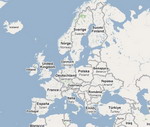|
Search
this site


View
map of Europe

View
map of Italy
|
 |






Buy
This Allposters.com
|
 Perugia
is the capital city of the region of Umbria in central Italy, near the
Tiber river, and the capital of the province of Perugia. Perugia
is the capital city of the region of Umbria in central Italy, near the
Tiber river, and the capital of the province of Perugia.
Perugia
Hotels
The city symbol is the griffin,
which can be seen in the form of plaques and statues on buildings around
the city. Perugia is a notable artistic center of Italy. The famous painter
Pietro Vannucci, nicknamed Perugino, was a native of Perugia. He decorated
the local Sala del Cambio with a beautiful series of frescoes; eight of
his pictures can also be admired in the National Gallery of Umbria. Perugino
was the teacher of Raphael, the great Renaissance artist who produced five
paintings in Perugia (today no longer in the city) and one fresco.
Another famous painter, Pinturicchio, lived in Perugia. Galeazzo Alessi
is the most famous architect from Perugia. |
Main sights
-
The Cathedral of S. Lorenzo.
-
The Palazzo dei Priori (Town
Hall, encompassing the Collegio del Cambio, Collegio della Mercanzia, and
Galleria Nazionale), one of Italy's greatest buildings. The Collegio del
Cambio has frescoes by Pietro Perugino, while the Collegio della Mercanzia
has a fine later 14th century wooden interior.
-
Galleria Nazionale dell'Umbria,
the National Gallery of Umbrian art in Middle Ages and Renaissance (it
includes works by Duccio, Piero della Francesca, Beato Angelico, Perugino)
-
Church and abbey of San Pietro
(late 16th century).
-
Basilica of San Domenico (begun
in 1394 and finished in 1458). It is located in the place where, in Middle
Ages times, the market and the horse fair were held, and where the Dominicans
settled in 1234. According to Vasari, the church was designed by Giovanni
Pisano. The interior decorations were redesigned by Carlo Maderno, while
the massive belfry was partially cut around mid-16th century. It houses
examples of Umbrian art, including the precious tomb of Pope Benedict XI
and a Renaissance wooden choir.
-
Church of Sant'Angelo (Founded
in the 6th century).
-
Church of San Bernardino (with
façade by Agostino di Duccio).
-
Fontana Maggiore, a medieval
fountain designed by Fra Bevignate and sculpted by Nicolò and Giovanni
Pisano.
-
Church of San Severo, retains
a fresco painted by Raphael and Perugino.
-
Ipogeo dei Volumni (Hypogeum
of the Volumnus family), an Etruscan chamber tomb
-
National Museum of Umbrian Archaeology,
where is conserved one of the longest inscription in Etruscan, the Cippus
perusinus.
-
Etruscan Arch (also known as
Porta Augusta), an Etruscan gate with Roman elements.
-
the Rocca Paolina, a Renaissance
fortress (1540-1543) of which only a bastion today is remaining. The original
design was by Antonio and Aristotile da Sangallo, and included the Porta
Marzia (3rd century BC), the tower of Gentile Baglioni's house and a mediaeval
cellar.
-
Centro Direzionale (1982-1986),
an administration civic center owned by the Umbria Region. The building
was designed by the Pritzker Architecture prizewinner Aldo Rossi.

Other attractions
-
The Etruscan Well (Pozzo Etrusco).
-
Medieval aqueduct.
-
The Tribunali.
-
Piazza Matteotti
-
Teatro Comunale Morlacchi.
-
Church of Sant' Agata.
-
Church of Sant' Ercolano (early
14th century). Currently resembling a polygonal tower, it had once two
floors. The upper one was demolished when the Rocca Paolina was built.
It includes Baroque decorations commissioned from 1607. The main altar
is made of a 4th sarcophagus found in 1609.
-
Church of Sant'Antonio da Padova.
-
 Church
of San Francesco al Prato. Church
of San Francesco al Prato.
|

Buy
This Allposters.com
|
-
Church of Santa Giuliana, heir
of a female monastery founded in 1253, which in its later years gained
a reputation for dissoluteness, until the French turned it into a granary.
It is now a military hospital. The church, with a single nave, has traces
of the ancient frescoes (13th century), which probably covered all the
walls. The cloister is a noteworthy example of Cistercian architecture
of the mid-14th century, attributed to Matteo Gattapone. This is contemporary
with the upper part of the campanile, whose base is from the 13th century.
-
Church of San Michele Arcangelo
(5th-6th centuries). It is an example of Palaeo-Christian art with central
plan recalling that of Santo Stefano Rotondo in Rome. It has 16 antique
columns.
-
Church of San Matteo in Campo
Orto.
-
Church of Santi Stefano e Valentino
-
Templar church of San Bevignate.
-
Orto Botanico dell'Università
di Perugia, the university's botanical garden
top
/ Perugia
Hotels
read
more |

FEATURED
PERUGIA AREA, UMBRIA SELF-CATERING / VACATION RENTAL ACCOMMODATION
|
|
 Apologies, due to the
self-catering search supplier shutting down, we currently have no properties
in this area.
Apologies, due to the
self-catering search supplier shutting down, we currently have no properties
in this area.
Should you have quality self-catering
accommodation in this area, please sign up for a
listing.
  Top Top

 |

